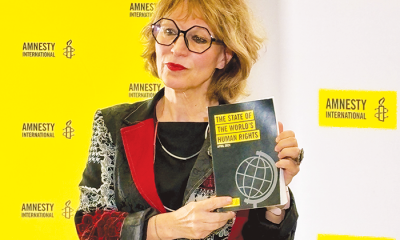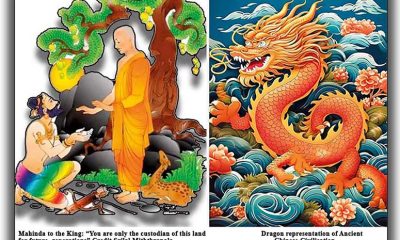Features
The Three Evils

By Dr. Justice Chadradasa Nanayakkara
Buddhism refers to three unwholesome states of mind that impede the spiritual progress of human beings. The unwholesome mental states are delusion (moha or ignorance), greed (raga or lust), and hatred (devesa or aversion). These three mental states encompass the entire range of evil, whether of lesser or greater intensity, from a faint mental tendency to the coarsest manifestations in action and speech. In other words, three unwholesome states of mind can exist in different proportions in different individuals. The Buddha described these three negative mental states by means of metaphors such as the three poisons, the three fires and the three roots that cause most of the problems in the world. The three evil states of mind are the primary causes that keep the beings trapped in samsara.
The three wholesome or positive mental factors that are identified as the opposites of the three unwholesome mental states described above are non-greed (alobha), non-hatred (adosa), and non-delusion (amoha). The antidote to unwholesome roots, though expressed negatively, does not signify the mere absence of the defiling characters but the presence of positive moral qualities, such as generosity (dana), loving-kindness (metta), and wisdom (panna) respectively. All these six mental states are the roots from which everything beneficial or harmful sprouts. (Nyanaponika).
Human beings are constantly prone to temptation to moral transgression, as unwholesome roots are firmly embedded in their mind. Their unwholesome actions (akusala) whether it is physical, verbal, or mental spring from the three unwholesome roots: greed, hatred, and delusion. Any action springing from these three roots would be detrimental to one’s spiritual well-being. Mental states propelled by roots of greed, hatred, and delusion expressed through the channels of the body and mind give rise to various heinous deeds such as murders, heists, robbing, stealing, affront and assaults, and other crimes. etc. On the other hand, wholesome action results from wholesome roots, non-greed, non-hatred, and non-delusion.
Often delusion and ignorance (avijja in Pali) are used as synonyms in Buddhism. Addressing bhikkhus, the Buddha declared, “I do not perceive any single hindrance other than the hindrance of ignorance by which humankind is obstructed and for so long a time runs on and wanders in samsara. it is indeed through the hindrance of ignorance that humankind is obstructed and for a long time runs on and wanders in samsara, no other single thing exists like the hindrance of delusion, which obstructs humankind and makes it wander forever.
Those who have abandoned delusion, cleaving through this mass of darkness, no longer roam and wander on, in them the cause is found no more.” (Itivattuka sutta).
Because of our fundamentally deluded or distorted outlook, we do not see things as they really are. We lull ourselves into a false sense of security because we are deluded into thinking that our world remains unchanged when, in fact, it does not. Everything is constantly changing although we fail to see everything is changing. This distorted outlook is nothing but our inability to see the Four Noble Truths and the three characteristics of our existence annica (impermanence), dukkha (suffering or dissatisfaction) and anatta (not-self) in their true perspective. The person who lives under this basic delusion and misperception tend to see things as permanent and substantial when in fact they are impermanent, to see happiness where in fact there is suffering, and to see things as self when in fact they are non-self. Delusion veils man’s mental eyes and prevents them from seeing the true nature of things.
Without delusion, no greed hatred can arise, as the unwholesome roots of greed and hatred always occur associated with delusion. Delusion, however, may occur by itself and can be a very powerful source of evil and suffering. Ignorance or delusion is said to be the greatest taint of the mind. Buddha declared “All unwholesome states of the mind have their root in ignorance, they converge upon ignorance, and by the abolishing of ignorance, all other unwholesome states are abolished. (SN) (Nanayaponika).
Nyanatilaka Mahathera referring to ignorance states “For all evil things and all evil destiny are really rooted in greed, hatred, and ignorance: and of these three things, ignorance or delusion (avijja or moha) is the chief root and the primary cause of all evil and misery in the world. If there is no more ignorance, there will be no more greed and hatred, no more rebirth, no more suffering.”
Therefore, Buddhism teaches the importance of freeing the mind from all unwholesome defilements, limitations, and fetters that tie a person to the wheel of suffering, to cycle rebirth and mar the purity of the mind.
The greed is another unwholesome mental state, which embraces all forms of appetite, such as desire, lust, craving, and longing and they are either physical or mental. It has the concept of grasping and leads to clinging and not letting go. Greed can be insatiable and inexhaustible.
A worldling is always attracted by pleasant and delightful things. He does not realize that no amount of forms, sounds, smells, tastes, tangibles, and mental objects will satisfy the eye, ear, nose, tongue, body, and mind. In his intense thirst for possession or gratification of desires, he gets bound to the wheel of samsara (Piyadassi). It must be realized that all mundane pleasures are fleeting. Our seeking of pleasure never ceases, particularly in a society driven by consumerist culture, as a result, we may find ourselves chasing after things that do not matter and become enslaved by them. Consumerist culture has brought about many changes in the normative values of the people. This has resulted in putting a relatively high priority on making a lot of money and accumulating material possessions by them. Unwholesome mental states dominated by greed, craving, clinging and lust, etc., create kamma that conditions a person to be reborn.
Hatred is another unwholesome mental state which can be fueled by a range of factors. Hatred can encompass such unwholesome mental states as anger, aversion, ill will, enmity, hostility, prejudice, aggression, etc., which are covered by the Pali term vyapada. Hatred consumes the person who harbors them and consumes others as well. People can harbor hatred in a very subtle way. Hate lies dormant in the mind of a worlding until he gives vent to it at an unexpected moment. Hatred can sometimes degenerate into mass-scale violence and bloodshed in a society.
Today, hatred and hostility against minorities on the basis of religion and ethnicity have been a regular feature in many countries. They have become targets of bigotry and hate. We see an upsurge of hateful, antagonistic, destructive, and derogatory behavior towards certain religious and ethnic groups in many communities.
Hatred, enmity, and retaliation do not foster spiritual well-being. Sometimes, people hate others because they assume that they are racially and morally superior to them. It must be remembered that hate vitiates our own mind and hatred in any form is denounced in Buddhism. Buddhists are expected to cultivate metta and affection which are opposite of the feelings of hatred.
Attachment and hatred coupled with ignorance are the chief causes of evil prevalent in this deluded world. “The enemy of the whole world is lust, through which all evils come to living beings. This lust when obstructed by some cause is transformed into wrath. (Narada) One is either attached to desirable external objects or repulsed with aversion towards undesirable objects. Because of aversion a person can recoil from undesirable objects and go to the extent of destroying them as their very presence is a source of irritation.
The Dhammapada states;
“There is no fire lust, no grip like hate, there is no net like delusion, no river like craving.”
Features
Kashmir terror attack underscores need for South Asian stability and amity

 The most urgent need for the South Asian region right now, in the wake of the cold-blooded killing by gunmen of nearly 30 local tourists in Indian-administered Kashmir two days back, is the initiation of measures that could ensure regional stability and peace. The state actors that matter most in this situation are India and Pakistan and it would be in the best interests of the region for both countries to stringently refrain from succumbing to knee-jerk reactions in the face of any perceived provocations arising from the bloodshed.
The most urgent need for the South Asian region right now, in the wake of the cold-blooded killing by gunmen of nearly 30 local tourists in Indian-administered Kashmir two days back, is the initiation of measures that could ensure regional stability and peace. The state actors that matter most in this situation are India and Pakistan and it would be in the best interests of the region for both countries to stringently refrain from succumbing to knee-jerk reactions in the face of any perceived provocations arising from the bloodshed.
The consequences for the countries concerned and the region could be grave if the terror incident leads to stepped-up friction and hostility between India and Pakistan. Some hardline elements in India, for instance, are on record in the international media as calling on the Indian state to initiate tough military action against Pakistan for the Kashmiri terror in question and a positive response to such urgings could even lead to a new India-Pakistan war.
Those wishing South Asia well are likely to advocate maximum restraint by both states and call for negotiations by them to avert any military stand-offs and conflicts that could prove counter-productive for all quarters concerned. This columnist lends his pen to such advocacy.
Right now in Sri Lanka, nationalistic elements in the country’s South in particular are splitting hairs over an MoU relating to security cooperation Sri Lanka has signed with India. Essentially, the main line of speculation among these sections is that Sri Lanka is coming under the suzerainty of India, so to speak, in the security sphere and would be under its dictates in the handling of its security interests. In the process, these nationalistic sections are giving fresh life to the deep-seated anti-India phobia among sections of the Sri Lankan public. The eventual result will be heightened, irrational hostility towards India among vulnerable, unenlightened Sri Lankans.
Nothing new will be said if the point is made that such irrational fears with respect to India are particularly marked among India’s smaller neighbouring states and their publics. Needless to say, collective fears of this kind only lead to perpetually strained relations between India and her neighbours, resulting in regional disunity, which, of course would not be in South Asia’s best interests.
SAARC is seen as ‘dead’ by some sections in South Asia and its present dysfunctional nature seems to give credence to this belief. Continued friction between India and Pakistan is seen as playing a major role in such inner paralysis and this is, no doubt, the main causative factor in SARRC’s current seeming ineffectiveness.
However, the widespread anti-India phobia referred to needs to be factored in as playing a role in SAARC’s lack of dynamism and ‘life’ as well. If democratic governments go some distance in exorcising such anti-Indianism from their people’s psyches, some progress could be made in restoring SAARC to ‘life’ and the latter could then play a constructive role in defusing India-Pakistan tensions.
It does not follow that if SAARC was ‘alive and well’, security related incidents of the kind that were witnessed in India-administered Kashmir recently would not occur. This is far from being the case, but if SAARC was fully operational, the states concerned would be in possession of the means and channels of resolving the issues that flow from such crises with greater amicability and mutual accommodation.
Accordingly, the South Asian Eight would be acting in their interests by seeking to restore SAARC back to ‘life’. An essential task in this process is the elimination of mutual fear and suspicion among the Eight and the states concerned need to do all that they could to eliminate any fixations and phobias that the countries have in relation to each other.
It does not follow from the foregoing that the SAARC Eight should not broad base their relations and pull back from fostering beneficial ties with extra-regional countries and groupings that have a bearing on their best interests. On the contrary, each SAARC country’s ties need to be wide-ranging and based on the principle that each such state would be a friend to all countries and an enemy of none as long as the latter are well-meaning.
The foregoing sharp focus on SAARC and its fortunes is necessitated by the consideration that the developmental issues in particular facing the region are best resolved by the region itself on the basis of its multiple material and intellectual resources. The grouping should not only be revived but a revisit should also be made to its past programs; particularly those which related to intra-regional conflict resolution. Thus, talking to each other under a new visionary commitment to SAARC collective wellbeing is crucially needed.
On the question of ties with India, it should be perceived by the latter’s smaller neighbours that there is no getting away from the need to foster increasingly closer relations with India, today a number one global power.
This should not amount to these smaller neighbours surrendering their rights and sovereignty to India. Far from it. On the contrary these smaller states should seek to craft mutually beneficial ties with India. It is a question of these small states following a truly Non-aligned foreign policy and using their best diplomatic and political skills to structure their ties with India in a way that would be mutually beneficial. It is up to these neighbours to cultivate the skills needed to meet these major challenges.
Going ahead, it will be in South Asia’s best interests to get SAARC back on its feet once again. If this aim is pursued with visionary zeal and if SAARC amity is sealed once and for all intra-regional friction and enmities could be put to rest. What smaller states should avoid scrupulously is the pitting of extra-regional powers against India and Pakistan in their squabbles with either of the latter. This practice has been pivotal in bringing strife and contention into South Asia and in dividing the region against itself.
Accordingly, the principal challenge facing South Asia is to be imbued once again with the SAARC spirit. The latter spirit’s healing powers need to be made real and enduring. Thus will we have a region truly united in brotherhood and peace.
Features
International schools …in action

 The British School in Colombo celebrated the 2025 Sinhala and Tamil New Year with the traditional rites and rituals and customs unique to the island nation, during a special Avurudu Assembly held at the school premises.
The British School in Colombo celebrated the 2025 Sinhala and Tamil New Year with the traditional rites and rituals and customs unique to the island nation, during a special Avurudu Assembly held at the school premises.
Students from all over the world, who are part of The British School in Colombo, gathered to celebrate this joyous event.
The special assembly featured traditional song and dance items from talented performers of both the Junior and Senior Schools.
On this particular day, the teachers and students were invited to attend school in Sri Lankan national costume and, among the traditional rituals celebrated, was the boiling of the milk and the tradition of Ganu-Denu.

Boiling of
the milk
In the meanwhile, a group of swimmers from Lyceum International School, Wattala, visited Australia to participate in the Global-ISE International Swimming Training Programme in Melbourne.
Over the course of 10 days, the swimmers followed an advanced training schedule and attended sessions at the Melbourne Sports and Aquatic Centre (MSAC), Victoria’s Nunawading Swimming Club, and Camberwell Grammar School.
In addition to their training, the group also explored Melbourne, with visits to key landmarks, such as the Parliament House and the Melbourne Cricket Ground (MCG), along with city tours and cultural experiences.

Traditional dance item

Tug-of-war contest

On arrival in Melbourne, Lyceum International School, Wattala, with Sri Lankan officials
Features
Perfect … and healthy

 Got a few more beauty tips to give you … for a perfect complexion, or, let’s say, a healthy skin.
Got a few more beauty tips to give you … for a perfect complexion, or, let’s say, a healthy skin.
* Honey Face Mask:
Take a tablespoon of raw honey and then warm it up by rubbing it with your fingertips. Apply the warm honey all over your face. Let this natural mask stand for about 10 minutes and then wash it off gently with warm water.
* Coconut Milk Face Mask:
You need to squeeze coconut milk out of a grated raw coconut and apply this milk all over your face, including your lips.
(This will help you gain a glowing skin. It is one of the best natural tips for skin care)
* Orange, Lemon, and Yoghurt Moisturiser:
To prepare this moisturiser, you need a tablespoon of orange juice, a tablespoon of lemon juice and a cup of plain yoghurt.
Mix them together and apply the paste all over your face, leaving it as a mask for 10 to 15 minutes. Next, take a damp handkerchief and use it to clean your face.
(This moisturiser brightens the complexion of your skin)
* Cucumber and Lemon:
Apply equal parts of cucumber and lemon juice on your face before taking a bath. Allow it to sit for 10 minutes before rinsing it off. This natural face beauty tip will brighten your skin tone and lighten blemishes if used on a regular basis. The best aspect is that it is appropriate for all skin types!
* Healthy Diet:
Aside from the effective home remedies, there are certain other factors to consider for skin care – and the first of them is your diet. Without the right nutrients, your skin cannot reverse the damage it suffers every day.
Eat fruits that are high in vitamin C because they contain antioxidants.
Adjust your diet to get the right amount of protein and unsaturated fats, as well as fresh green vegetables. All of this provides the right amount of nutrients so your skin can heal and improve itself naturally.
* Sun Protection and Care:
Another thing to keep in mind is not to step out of your home without sunscreen, especially with this awful heat we are experiencing at the moment. The hard rays of the sun can do you more damage than you could ever imagine.
By the way, you can prepare your own sunscreen lotion with glycerin, cucumber juice and rose water. You can also keep this lotion in the fridge.
-

 Business5 days ago
Business5 days agoDIMO pioneers major fleet expansion with Tata SIGNA Prime Movers for ILM
-

 News4 days ago
News4 days agoFamily discovers rare species thought to be extinct for over a century in home garden
-

 Features6 days ago
Features6 days agoProf. Lal Tennekoon: An illustrious but utterly unpretentious and much -loved academic
-

 Foreign News5 days ago
Foreign News5 days agoChina races robots against humans in Beijing half marathon
-

 Editorial5 days ago
Editorial5 days agoSelective use of PTA
-

 Features2 days ago
Features2 days agoRuGoesWild: Taking science into the wild — and into the hearts of Sri Lankans
-

 News2 days ago
News2 days agoOrders under the provisions of the Prevention of Corruptions Act No. 9 of 2023 for concurrence of parliament
-

 Features4 days ago
Features4 days agoThe ironies of history
























